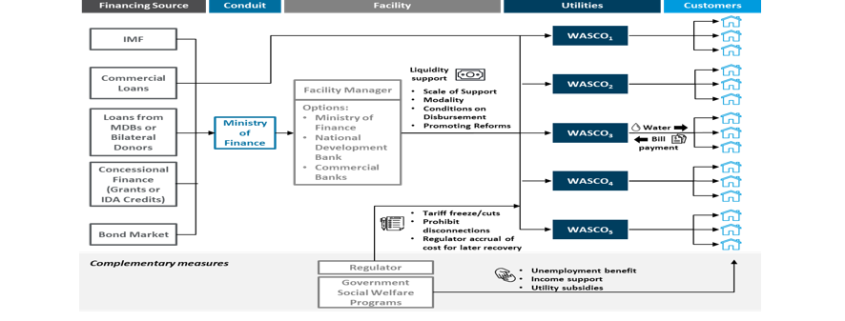Frequently Asked Questions about designing a liquidity facility
Last week Castalia posted a blog about how Liquidity Facilities could be the solution to providing emergency financial support to water utilities in response to the COVID-19 pandemic. We received a lot of interesting comments about the relevance of this topic (for example, U.S. water utilities actively lobbying Congress to get stimulus money to compensate for their COVID-related losses) and thoughtful questions about the detailed design of these Facilities.
So the Chief Executive of Castalia, David Ehrhardt (DE) answered some of the frequently asked questions about the options in the design of a Facility.
Question 1: How should the scale of required financial support be assessed?
DE response: In this fast-moving crisis, we need quick options to assess financial need. These include existing utility financial models and a World Bank model created for this purpose (COVID-19 Financial Impact Assessment Tool for Water Service Providers). These can be done utility by utility and then added up for a national estimate. Alternatively, data from other similar countries could be used if available. Obviously, you should do high and low scenarios as well as a base case.
Question 2: Will the Facility be a national body, or could it be regional or subnational?
DE response: Almost all Facilities will be at the national level because the money in the Facility has to come from (or be guaranteed by) the national government. That being said, there could be exceptions such as a regional facility for small nations with regional institutions already in place (such as the Organization of Eastern Caribbean States); or a state-level Facility in Federal Systems with states or provinces having responsibility for water (as in Brazil, Nigeria, and India).
Question 3: Which entity will manage the Facility?
DE response: Using existing institutions to manage the Facility will make the Facility quicker to get up and running. Some options for a Facility Manager include:
- A national development bank (such as BNDES in Brazil) or water sector financing agency (such as LWUA in the Philippines)
- A unit in the Ministry of Finance that has experience running government grant or loan schemes and fiscal transfers
- A bank operating under contract to the government with strict guidelines and clear responsibilities, or offering loans with government guarantees (similar to the US Paycheck Protection Program for general business continuity), again with clear guidelines and responsibilities
- A regional development bank or monetary authority (such as the OECS Central Bank or the Caribbean Development Bank), in those cases where a regional fund is judged to be appropriate.
Question 4: What monitoring and fiduciary arrangements are needed?
DE response: At a minimum, the Facility will need a Procedures manual; agreements or contracts with the recipient utilities; accounting systems; clarity on the role of the independent auditor; and clarity on the role of the regulatory entity.
Question 5: What sources can finance the Facility?
DE response: In the majority of cases, the government is going to have to put up the money, or at least guarantee it. In developing countries, the government’s first source of finance during this crisis is likely the IMF and then multilateral and bilateral development finance institutions. To pay out large amounts of cash to water utilities, the government will need to borrow large amounts of money and potentially borrow more money over time. It, therefore, makes sense to set up a Facility that can aggregate money from several different sources at several different times.
Question 6: How will funds be disbursed from the Facility to utilities?
DE response: This is a great question. I think that the modality for disbursement should be loans because the Facility can get the money out the door quickly while also encouraging performance improvements and minimizing fiscal costs (of course, there could still be a fiscal cost because some utilities may default on their loan. In these cases, the disbursement could be converted to a grant). Another good option is for the government to guarantee lending from a commercial bank because it shifts the burden of loan administration to the commercial bank and brings utilities and banks together. All that being said, grants are obviously the simplest, quickest option.
Question 7: Should the Facility attempt to promote utility reforms?
DE response: I think that, at the very least, the designer of the Facility should consider attaching reform requirements to assistance from the Facility. Water utilities, and importantly, their inefficiencies, are finally getting the attention of the Minister of Finance. This creates a rare opportunity to have multi-level stakeholder support for vital reforms. Of course, though I encourage considering promoting reforms, the designer of the Facility must remember that the overriding aim must be to quickly get money to utilities in sufficient quantities to allow them to remain operational.
DE closing remarks: Thank you for all of your thoughtful questions. Please comment to let us know your thoughts and if you think we have missed some important option or consideration. I look forward to continuing this discussion with all of you. If anyone reading needs help with these questions, please let me know
Interviewed by: Lisa Nations.


